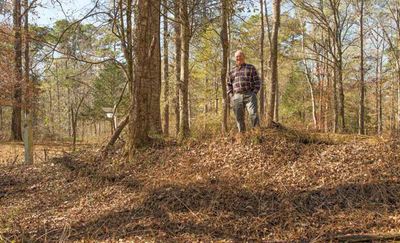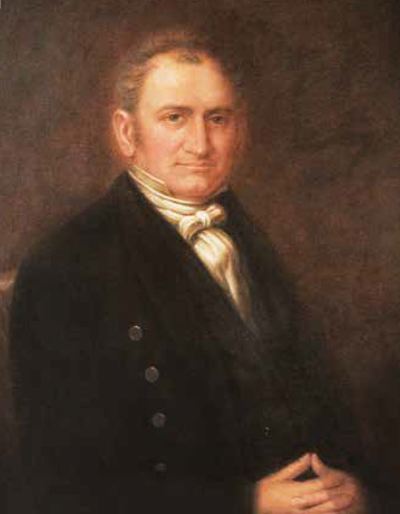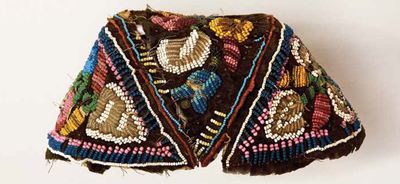On January 19, 1818, the members of the Alabama Territory’s legislature gathered in St. Stephens for the first of two lawmaking sessions conducted prior to statehood. All thirteen members present—twelve lower house members and one upper—originally had been elected to the Mississippi Territory’s General Assembly. To facilitate organizing the government of Alabama, the act enabling division of the territory had specified these representatives would serve the remainder of their terms as Alabama’s legislators. Befitting Alabama’s humble and hurried origins, they met in rented rooms at the Douglas Hotel. Appointed Gov. William Wyatt Bibb set the tone for administering business at hand in his written address to the assembly, which recommended careful attention to internal improvements and the promulgation of the means of education. Thus keeping one eye firmly on the future state they planned to erect, over the course of the next four weeks the legislators laid the groundwork for their own government.
In a flurry of activity, the General Assembly established the inner workings of government and organized a few basic services for its citizenry. It chartered the territory’s first school (St. Stephens Academy) and bank (Tombeckbe) and selected Creek Indian Agent John Crowell as Alabama’s delegate in the nation’s capital. It also organized over a dozen new counties, forming, on paper at least, a continuous line of jurisdiction stretching from the Tennessee River to the Gulf of Mexico. Few maps of the Alabama Territory were ever made, but those that survive illustrate the uneasy coexistence between settlers and Native Americans that characterized Alabama’s early development. The territory’s heart lay flanked, east and west, by the remnants of domains claimed by four powerful tribes—the Creek, Choctaw, Chickasaw, and Cherokee—while most of the remainder had recently been in Indian hands.
Alabama’s residents were keenly aware that they were forming a new political entity in a frontier region amidst sizeable populations of indigenous peoples. Writer Anne Royall’s account of the transition’s suddenness read as a pro-found Alabama allegory: “this land was abandoned last fall by the Indians. The fires were still smoking, when the white people took possession.”
As late as 1806, only two small tracts in the extreme north and southwest of Alabama had legally opened to American settlement. The lion’s share had been ceded between 1814 and 1816. In a three-year span, the entire population dynamic in the region was reversed, and Native Americans found themselves literally clinging to the fringes of the new territory. While portions of their once-vast do-main would remain in their possession for another generation, its ultimate surrender to the obdurately expanding United States seemed, even then, virtually foreordained to the new arrivals. After all, by the time the Alabama Territory became a centerpiece destination of the advancing tide of American settlement, the young nation already had a wealth of experience in divesting the Indians of land.
Alabama’s Native Americans watched with a complicated combination of unease, anger, and resignation. The Creek War of 1813–1814 had been the most concerted military effort by any regional native group to reverse the American onslaught with which they had been besieged since the Revolutionary War. However, diplomatic and economic trends connecting tribes with global trading networks had bolstered their efforts to preserve borders and cultural integrity. Such maneuvering kept relatively weak colonial powers at bay for over a century, but it proved inadequate in meeting the challenge of the advancing American juggernaut. Early Alabama settlers encountered natives who were anything but the insulated primitives of inaccurate popular lore.
Alabama’s residents were keenly aware that they were forming a new political entity in a frontier region amidst sizeable populations of indigenous peoples. Writer Anne Royall’s account of the transition’s suddenness read as a pro-found Alabama allegory: “this land was abandoned last fall by the Indians. The fires were still smoking, when the white people took possession.”
As late as 1806, only two small tracts in the extreme north and southwest of Alabama had legally opened to American settlement. The lion’s share had been ceded between 1814 and 1816. In a three-year span, the entire population dynamic in the region was reversed, and Native Americans found themselves literally clinging to the fringes of the new territory. While portions of their once-vast do-main would remain in their possession for another generation, its ultimate surrender to the obdurately expanding United States seemed, even then, virtually foreordained to the new arrivals. After all, by the time the Alabama Territory became a centerpiece destination of the advancing tide of American settlement, the young nation already had a wealth of experience in divesting the Indians of land.
Alabama’s Native Americans watched with a complicated combination of unease, anger, and resignation. The Creek War of 1813–1814 had been the most concerted military effort by any regional native group to reverse the American onslaught with which they had been besieged since the Revolutionary War. However, diplomatic and economic trends connecting tribes with global trading networks had bolstered their efforts to preserve borders and cultural integrity. Such maneuvering kept relatively weak colonial powers at bay for over a century, but it proved inadequate in meeting the challenge of the advancing American juggernaut. Early Alabama settlers encountered natives who were anything but the insulated primitives of inaccurate popular lore.
By the time the Alabama Territory became a centerpiece destination of the advancing tide of American settlement, the young nation already had a wealth of experience in divesting the Indians of land.
In truth, long before 1817, Alabama’s Indians had experienced profound cultural change wrought by unavoidable contact with Europeans, Africans, and ultimately, white American settlers. Native Americans in the Alabama Territory farmed the same crops as their white neighbors, often with slave labor; sometimes operated businesses such as inns and ferries; and not infrequently intermarried with white families to the point that some of their most influential leaders carried names such as McGillivray, McIntosh, Weatherford, Perryman, and Colbert. The latter, brothers George and Levi Colbert, personified this new type of Native American leader who, astride two worlds, successfully wielded influence in both. Chickasaw chiefs, the brothers helped negotiate treaties between the Chickasaws and settlers, operated assorted businesses catering to a distinctly white clientele, and employed slave labor on their expansive plantations.
Despite the many surface signs of peaceful coexistence, if not outright assimilation, between settlers and native groups after the Creek War, a startling reminder that the Alabama Territory lay within a still-contested frontier region appeared in March 1818. In the winter of 1817–1818, the smoldering embers of Red Stick Creek resistance suddenly rekindled among a remnant of the defeated nation and their Seminole cousins in Florida. What began as isolated disputes over trespassing and cattle theft along the Georgia-Florida line quickly flared into a confrontation eventually known as the First Seminole War.
On March 13 a group of Creek warriors led by a man known as Savannah Jack attacked the Ogly home in what was then Monroe County, near modern Greenville. The warriors, believed to have been inspired as much by deep-seated resentment over the recent cession of Creek lands as by the current border feud, gunned down William Ogly in his doorway, then rushed into the cabin his family and a visiting family, the Strouds, occupied. In the grisly carnage that followed, Mrs. Stroud was tomahawked and left for dead, and several children were cruelly butchered. A week later, militiamen were attacked near Fort Claiborne, leaving two more dead. Several other isolated acts of violence occurred in subsequent weeks, even as forts popped up in the territory’s southern portion to protect settlers. The scene eerily resembled the summer of 1813 in the days before the infamous attack on Fort Mims, and intense panic forced the territory’s fledging government into action. In his administration’s first true crisis, Governor Bibb personally visited settler stockades, sought assistance from allied Creeks and the Federal government, and ordered militia to pursue the hostile raiders. Almost as suddenly as tensions had flared up, however, they dissipated when Andrew Jackson invaded the Spanish province of Florida to quell the Seminole threat.
Events such as the Ogly affair reminded both natives and American settlers how quickly deep-seated cultural differences could devolve into violence and tinted virtually all interaction between the two peoples. They were neighbors, often friends, frequently business partners, and not infrequently even kin. But underlying even the best relationships lurked profound mistrust. Native Americans had endured a long, painful series of losses by the time Alabama established its borders, and early settlers arrived with the accumulated baggage of equally negative experiences that cast Native Americans as inherently untrustworthy and inferior. Thus, in a manner similar to the dread of insurrection among slaveholders, fear promulgated attitudes and policies that wrongly equated Native Americans with a human barrier impeding Alabama’s rightful destiny. Removing that perceived obstacle would command a great deal of the energies of early Alabama’s leaders even as other hurdles demanded their attention.
Despite the many surface signs of peaceful coexistence, if not outright assimilation, between settlers and native groups after the Creek War, a startling reminder that the Alabama Territory lay within a still-contested frontier region appeared in March 1818. In the winter of 1817–1818, the smoldering embers of Red Stick Creek resistance suddenly rekindled among a remnant of the defeated nation and their Seminole cousins in Florida. What began as isolated disputes over trespassing and cattle theft along the Georgia-Florida line quickly flared into a confrontation eventually known as the First Seminole War.
On March 13 a group of Creek warriors led by a man known as Savannah Jack attacked the Ogly home in what was then Monroe County, near modern Greenville. The warriors, believed to have been inspired as much by deep-seated resentment over the recent cession of Creek lands as by the current border feud, gunned down William Ogly in his doorway, then rushed into the cabin his family and a visiting family, the Strouds, occupied. In the grisly carnage that followed, Mrs. Stroud was tomahawked and left for dead, and several children were cruelly butchered. A week later, militiamen were attacked near Fort Claiborne, leaving two more dead. Several other isolated acts of violence occurred in subsequent weeks, even as forts popped up in the territory’s southern portion to protect settlers. The scene eerily resembled the summer of 1813 in the days before the infamous attack on Fort Mims, and intense panic forced the territory’s fledging government into action. In his administration’s first true crisis, Governor Bibb personally visited settler stockades, sought assistance from allied Creeks and the Federal government, and ordered militia to pursue the hostile raiders. Almost as suddenly as tensions had flared up, however, they dissipated when Andrew Jackson invaded the Spanish province of Florida to quell the Seminole threat.
Events such as the Ogly affair reminded both natives and American settlers how quickly deep-seated cultural differences could devolve into violence and tinted virtually all interaction between the two peoples. They were neighbors, often friends, frequently business partners, and not infrequently even kin. But underlying even the best relationships lurked profound mistrust. Native Americans had endured a long, painful series of losses by the time Alabama established its borders, and early settlers arrived with the accumulated baggage of equally negative experiences that cast Native Americans as inherently untrustworthy and inferior. Thus, in a manner similar to the dread of insurrection among slaveholders, fear promulgated attitudes and policies that wrongly equated Native Americans with a human barrier impeding Alabama’s rightful destiny. Removing that perceived obstacle would command a great deal of the energies of early Alabama’s leaders even as other hurdles demanded their attention.



 RSS Feed
RSS Feed